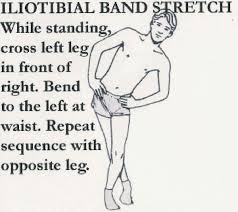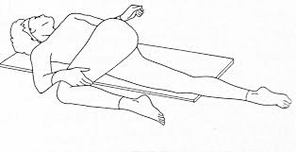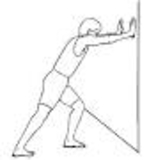Knee pain can be a functionally limiting ailment. Walking is a necessary part of life for us as human beings – and knee pain will make walking very difficult. What we have found to be true while researching evidence and also by practicing in clinic practice is that the knee is the weak-link in the lower extremity kinetic chain. If any part of the chain – from the lower back to the ankle, is injured or weak, then many times the symptoms only show up in the knee. So, in many non-traumatic type knee pain, the problem is not with the knee itself, but with the hip or ankle.
The hip becomes weak from non-use, or a minor back injury, and then gets weak. The hip flexors aren’t able to advance the leg as needed during walking, and thus the hip abductors are called on to help with that job, thus causing a lateral movement of the kneecap and thus a slow wearing down of the lateral cartilage of the patella.
The cartilage begins to fray and wear off and then pain occurs in the knee. We help alleviate knee pain at Eagle Rock Physical Therapy by stopping the lateral tracking of the kneecap, by strengthening the hip flexors, mobilizing the knee cap, stretching the IT-band and the hip flexors, and working out myofascial trigger points in the IT-band and hip flexors. We also employ taping techniques to assist the body in the healing process as needed. We also assess the ankle to be sure that the ankle part of the kinetic chain is not causing the knee pain. If the ankle needs to be repaired, we repair it.
The following exercises are only the exercises that help most people – many times further manual hands-on treatment is necessary, in addition to exercises, to fully alleviate pain. The manual treatment consists of aligning the joint, releasing trigger points, and providing the right environment for healing. If your knee pain worsens with these exercises, consider coming to Eagle Rock Physical Therapy where we can help you live with no knee pain.
IT-BAND SYNDROME
 Lateral knee pain can be a common cause of knee pain – but have the same problem with greater trochanteric bursitis with Hip Pain. The IT-band originates on the illiim bone – which is above the hip – and courses over the greater trochanter of the femur and connects to Gerdy’s tubercle on the tibia (bone below knee). It also has some connection to the outside of the kneecap. Thus, when the IT-band gets overworked, or it is too tight, then pain can happen on the lateral side of the kneecap as well. Mobilization, at times, is needed on the tubercle and then exercises to promote strength around the knee.
Lateral knee pain can be a common cause of knee pain – but have the same problem with greater trochanteric bursitis with Hip Pain. The IT-band originates on the illiim bone – which is above the hip – and courses over the greater trochanter of the femur and connects to Gerdy’s tubercle on the tibia (bone below knee). It also has some connection to the outside of the kneecap. Thus, when the IT-band gets overworked, or it is too tight, then pain can happen on the lateral side of the kneecap as well. Mobilization, at times, is needed on the tubercle and then exercises to promote strength around the knee.PIRIFORMIS STRETCH
 This is a good stretch for the piriformis muscle – more are found in the Low Back Pain page. By stretching this IT-band, the friction on the outside of the knee can be relieved and full function can be restored.
This is a good stretch for the piriformis muscle – more are found in the Low Back Pain page. By stretching this IT-band, the friction on the outside of the knee can be relieved and full function can be restored.
GASTROC STRETCH
 The calf (gastroc) stretch is great for the ankle – and also great for the knee as this muscle crosses both joints. By stretching out this muscle, there is a posterior force removed from the knee and pain can be alleviated.
The calf (gastroc) stretch is great for the ankle – and also great for the knee as this muscle crosses both joints. By stretching out this muscle, there is a posterior force removed from the knee and pain can be alleviated.